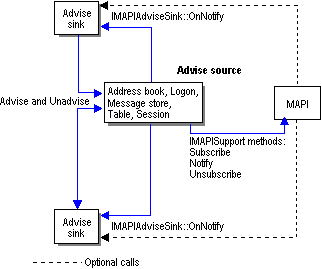
| Platform SDK: MAPI |
Event notification is the communication of information between two MAPI objects. Through one of the objects, a client or service provider registers an interest in learning of a change or error, called an event, that may take place in the other object. After the event occurs, the first object is informed, or notified. The object receiving the notification is called the advise sink; the object responsible for the notification is called the advise source.
There are three types of advise sink objects; all types are standard MAPI objects:
Advise sink objects are the most common type. Advise sinks are typically implemented by client applications to receive address book and message store notifications and support the IMAPIAdviseSink interface. IMAPIAdviseSink contains a single method, OnNotify. Form and view advise sinks are less common; they are implemented to receive notifications about changes to custom forms. Form advise sinks support the IMAPIFormAdviseSink interface and view advise sinks support the IMAPIViewAdviseSink interface. Because most clients implement standard advise sink objects, assume that discussions of notifications relate to address book and message store notifications rather than forms notifications. For more information about forms notifications, see Forms Notifications and Writing Form Server Code.
Advise source objects are implemented by service providers and by MAPI. Not all service providers support event notification; it is optional, but strongly recommended. Message store and address book providers usually support object notifications on several of their objects and table notifications on their contents and hierarchy tables. Transport providers do not support notifications directly; they rely on alternative methods of communication with clients.
Unlike advise sinks, advise source objects are not a unique type of MAPI object. Many MAPI objects, such as message stores and tables, can take on the role of advise source. An advise source is any MAPI object that:
Clients implementing advise sink objects call Advise when they want to register for a notification, in most cases passing in the entry identifier of the object with which registration should occur, and Unadvise when they want to cancel the registration. Clients pass a parameter to Advise that indicates which of the several types of events they want to monitor. Advise returns a nonzero number that represents a successful connection between the advise sink and advise source.
Before calling Advise, clients can determine if a message store provider supports notification by checking that the STORE_NOTIFY_OK flag is set in the message store's PR_STORE_SUPPORT_MASK property. There is no way for clients to determine ahead of time whether or not an address book provider supports notifications. Clients must attempt to register and if the attempt fails, they can assume notifications are unsupported.
When an event for which a client has registered occurs, the advise source notifies the advise sink by calling its IMAPIAdviseSink::OnNotify method with a notification data structure that contains information about the event. An advise sink's implementation of OnNotify can perform tasks in response to the notification, such as updating data in memory or refreshing a screen display.
Service providers can implement support for notifications manually or take advantage of the help provided in three IMAPISupport methods: Subscribe, Unsubscribe, and Notify. The Subscribe and Unsubscribe methods handle notification registration and deregistration for providers; the Notify method handles sending notifications when appropriate.
To use the support object methods for notification registration, service providers call IMAPISupport::Subscribe in their Advise methods and pass to Subscribe the advise sink pointer that clients pass to Advise. If an entry identifier is passed as an input parameter to specify an advise source, service providers convert it to a binary key. Subscribe creates a unique connection number and it is this number that service providers return to clients. Service providers can release the client's advise sink object pointer at any time after the Advise call has completed.
When clients call Unadvise to cancel a registration, service providers either decrement the reference count on the client's advise sink pointer or call Unsubscribe to do the same.
When it is time to generate a notification, service providers perform any internal processing that relates to the notification and initializes a NOTIFICATION structure by setting all of its unused members to zero. This technique for initializing the NOTIFICATION structure can help clients create smaller, faster, and less error-prone OnNotify implementations.
The following diagram shows the communication between advise sink objects, advise source objects, and MAPI. MAPI is involved only when the advise source calls the IMAPISupport methods for notification support.
